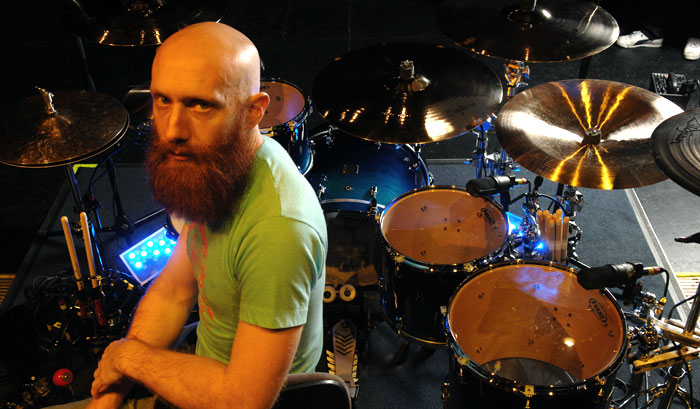


What's the difference between a classical percussionist and a heavy metal drummer?
Sounds like the setup for a bad drummer joke. But in the case of Justin Foley, the answer is simply, "None--they're the same person." Before joining Massachusetts metal outfit Killswitch Engage, Foley gigged regularly with various New England orchestras.
For Justin, the two styles have a symbiotic relationship. "Playing in orchestras or chamber ensembles fine-tunes your ear and makes you a great listener," he says. "Also, the independence I acquired from playing classical vibraphone and marimba with four mallets has definite parallels to the independence you need on a drum kit. On the other hand, you get a lot of passion from playing rock and metal, and I think I carry that over into my classical playing."
If I didn't endorse Yamaha drums, I'd be playing them anyway.
While pursuing his Masters degree in percussion performance from the Hartt School of Music in his native Connecticut, Foley played with several popular bands, including Red Tide and Blood Has Been Shed. Blood vocalist Howard Jones eventually left the band to join Killswitch Engage, and Justin followed him a year later, replacing drummer Tom Gomes. Foley lent new thunder to Killswitch's 2004 End of Heartache album and to this year's As Daylight Dies.
For Foley, the trickiest part of joining the group is balancing between maintaining the established Killswitch sound and expressing his own personality. "Killswitch is more groove-oriented than my previous bands," he notes. "I always used to practice playing as many notes as I could play, and learning not to do that was more of a challenge than I'd anticipated. But as I got more comfortable, I found ways to expand on the grooves while still fitting in with what everyone else was doing."
Justin insists he doesn't feel hemmed in. "If anything," he says, "it's more challenging to play this way. It was fun in the past when I'd play as many notes as I could or put several time signatures on top of each other. But it's even harder to create something so subtle that the listener may not even pick up on it, but that gives a little extra push to a song."
A classical pedigree isn't the only thing that makes Foley an atypical metal drummer: He also favors a small kit. "I have a 20" kick and 10", 13", and 15" toms," he says. "It's a Yamaha Absolute Maple kit with Nouveau lugs, plus a Mike Bordin signature snare--a really cool half-hammered copper drum. People are always surprised when they see my kit. On our last tour, the other two bands had big drum kits. Then we'd come out, and there'd be this tiny little guy with a tiny little kit on a one-foot riser."
Why the small kit? "Well," says Justin, "I used to play big drum sets--at one point, I had a nine-piece kit. But the more my bands got into writing songs, the fewer drums I used. I eventually settled on a five-piece. Also, when I was starting out, I'd never play gigs with real PAs or good micing. When I'd listen to the other bands, I'd noticed how you could never hear the toms--they just couldn't cut through the distortion of the guitars. So I started using smaller toms to cut through. Then I really started to like the way small toms sound when they're tuned low. As for the kick, the Yamaha 20" sounds huge. A lot of guys are going back to using two drums for double-kick work, but I prefer one drum with a double pedal. I like the way a single-kick setup lets me do a lot of leftfoot stuff on the hi-hat pedal, plus I like the consistency of the one-kick sound. A lot of times when people use two kicks, the drums sound too different."
"I was thrilled when I became a Yamaha endorsee," adds Justin. "I bought my first Yamaha kit in 1992 when I was 16. If I didn't endorse Yamaha drums, I'd be playing them anyway." He chuckles. "Amazing how that worked out." When he's not on tour with Killswitch Engage, Foley still accepts orchestral gigs. "People ask if I ever get confused going back and forth between the two styles," he says. "The answer is no--they're definitely two different mindsets. But I get as much of a rush from playing triangle in an orchestra as I've had playing onstage in a band."
























